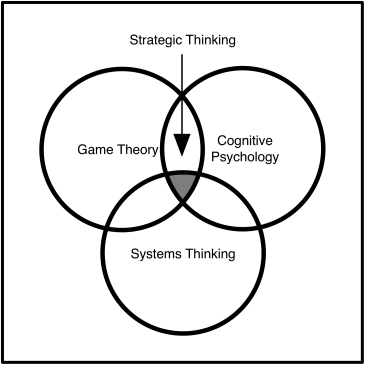1Fundamentals of Strategic Thinking and Leadership
To adequately address the issues and questions we raised in the Introduction, we must recognize and understand the nature of strategic thinking and leadership. To do so, we will begin by addressing each as an independent topic. We will also explore the important relationship between them. After reviewing their nature and elements, we will turn our attention to their application through several stories of strategic thinking and leadership in action.
The Nature of Strategic Thinking
Achieving a meaningful understanding of strategic thinking involves addressing several interrelated topics. From an academic perspective, we see strategic thinking at the intersection of three fields of study: cognitive psychology, systems thinking, and game theory.

Figure 1.1 The Three Components of Strategic Thinking
Cognitive psychology is the study of perception, creativity, decision making, and thinking. Systems thinking is an approach to understanding how systems behave, interact with their environment, and influence each other. Game theory is the study of decision making when the decision involves two or more parties (the decision maker and the opponent or adversary). While these are all academic disciplines, they address highly practical real-world matters. Applying cognitive psychology helps you manage your biases and blind spots. Systems ...
Get Leading with Strategic Thinking: Four Ways Effective Leaders Gain Insight, Drive Change, and Get Results now with the O’Reilly learning platform.
O’Reilly members experience books, live events, courses curated by job role, and more from O’Reilly and nearly 200 top publishers.

